To read a full report, please download PDF
JPY in full focus after sharp correction stronger
FX View:
The US dollar is rebounding and has gained this week against all G10 currencies apart from the yen. The US jobs report was on the modestly stronger side of consensus and there was enough evidence of reasonable labour market conditions for the Fed next week to push back on the scale and timing of easing now priced into the market. The yen could weaken if the dollar recovers somewhat on this scenario but the weight of short yen positioning that likely still exists following the move this week will probably limit the scale of any yen retracement weaker. We may well look back at this week as the marker of a longer-term turn in the yen depreciation trend that has been synonymous the post-covid global inflation shock. While BoJ developments were the catalyst for the move this week, it is the change in broader global macro and market conditions that will prove most important.
JPY SHINES THIS WEEK AS SHORT POSITIONS ARE SQUEEZED ON BOJ FOCUS
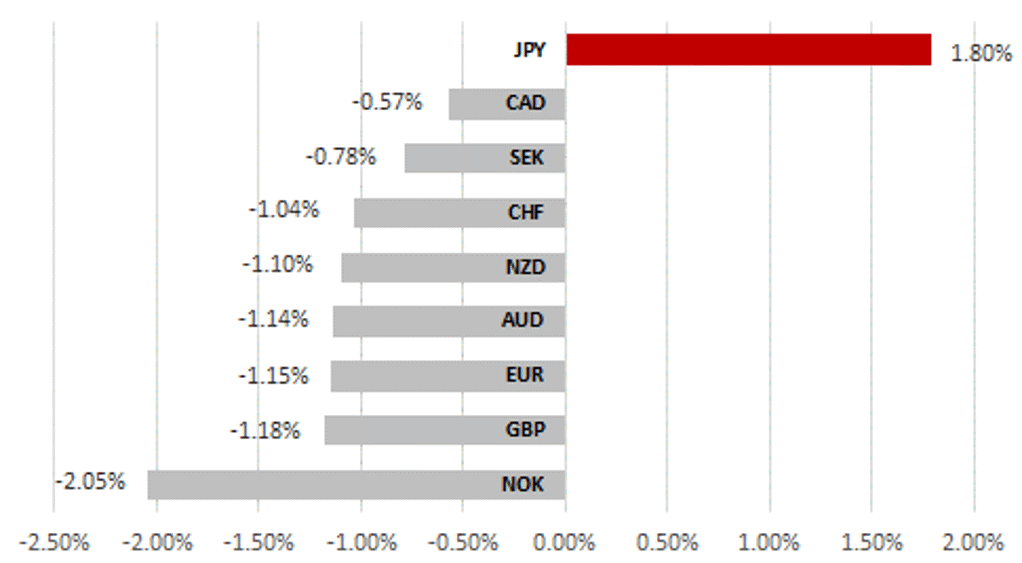
Source: Bloomberg, 13:45 GMT, 8th December 2023 (Weekly % Change vs. USD)
Trade Ideas:
Our profit target level in our short USD/JPY trade was hit. We have re-established a long yen position this time against euro ahead of next week’s central bank meetings which may prove more negative for euro.
JPY Flows:
The monthly International Transactions in Securities data was released today by the MoF for November. The sharp drop in global yields did not draw Japanese investors to global bond markets and were net sellers of foreign bonds.
Yen Flow Buy-Sell Indicator:
Our analysis highlights that our internal flows for USD/JPY showed net selling this week. It was only the fourth week this year that there was overall net selling. Please see the piece for flow breakdown by different customer segments.
FX Views
USD/JPY: BoJ / Fed – peak divergence finally hits home
The BoJ this week certainly looks to be readying the markets for a more meaningful shift in its policy after maintaining an ultra-loose monetary stance throughout the largest global inflation shock since the late 1970s / early 1980s. That reality seems to have dawned on market participants yesterday with a high-to-low drop of 3.8% in USD/JPY in the wake of comments from BoJ Governor Ueda. In the Diet, Governor Ueda delivered his semi-annual testimony on currency and monetary control and stated according to Bloomberg that “it will become even more challenging from the year-end and heading into next year”. This reference to year-end has lifted expectations of action at the BoJ policy meeting on 19th December. USD/JPY dropped a large 2% yesterday for the biggest one-day drop since January. The US data released this week has done little to alter the growing consensus of notable rate cuts by the Fed next year – the markets finally seem to be taking on board the fact that the peak BoJ-Fed divergence is now behind us which is a key for USD/JPY.
We were amazed by the lack of financial market reaction to Deputy Governor Himino’s speech on Wednesday. For us the content of his speech was more akin to the BoJ laying the groundwork for a hike – essentially by walking through the possible impacts of a rate hike and providing quite positive conclusions. The BoJ has posted his speech (click here) so there is no translation mis-interpretations here. Deputy Governor Himino lays out in Part II on monetary policy the possible impacts on the household sector; the corporate sector; and for financial institutions. In highlights possible benefits for all three areas of the economy and the speech certainly reads more like the central bank attempting to allay fears over the potential disruption to the economy from the lifting of nominal rates. The speech got little market attention initially but Ueda’s comments today helped market participants to refocus on Himino’s speech and combined with Ueda’s comments yesterday helped fuel a big move.
It is somewhat bizarre that this JPY move and increased speculation on a BoJ hike happened yesterday rather than on Wednesday. Governor Ueda’s comments yesterday were in fact much more balanced, even cautious on the view that inflation is becoming sustainable. He stated it was too early to conduct an exit simulation and that now was not the time to focus on exit. He also stated that the BoJ still did not see certainty in achieving the inflation goal. These comments in the Diet don’t appear to signal an imminent change and hence we maintain our view that the BoJ will end both YCC and NIRP at the January MPM.
BOJ RATE HIKE EXPECTATIONS PICK UP AGAIN
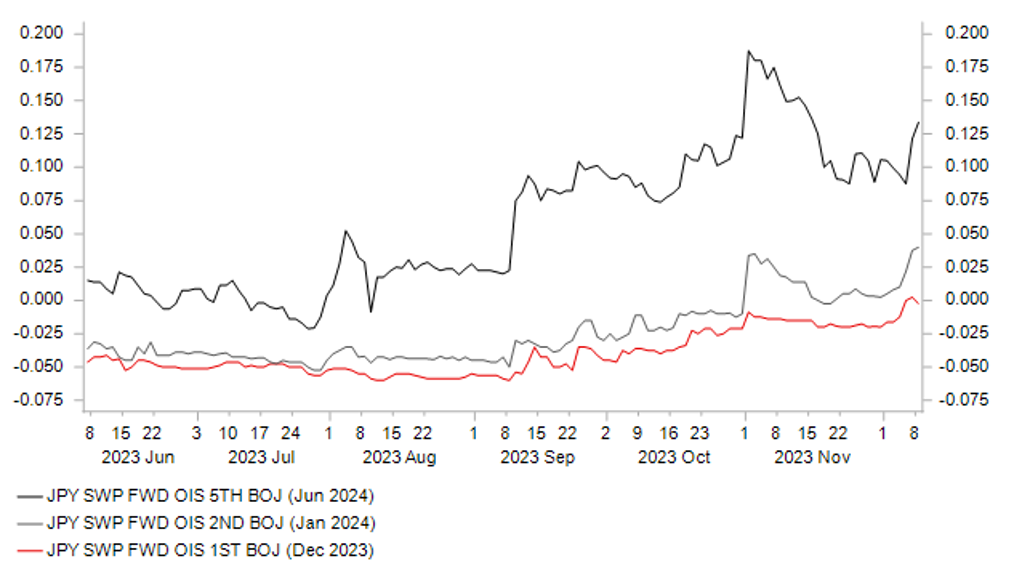
Source: Bloomberg, Macrobond & MUFG GMR
JAPAN JOB OPENINGS, WAGES, CPI ALL ELEVATED
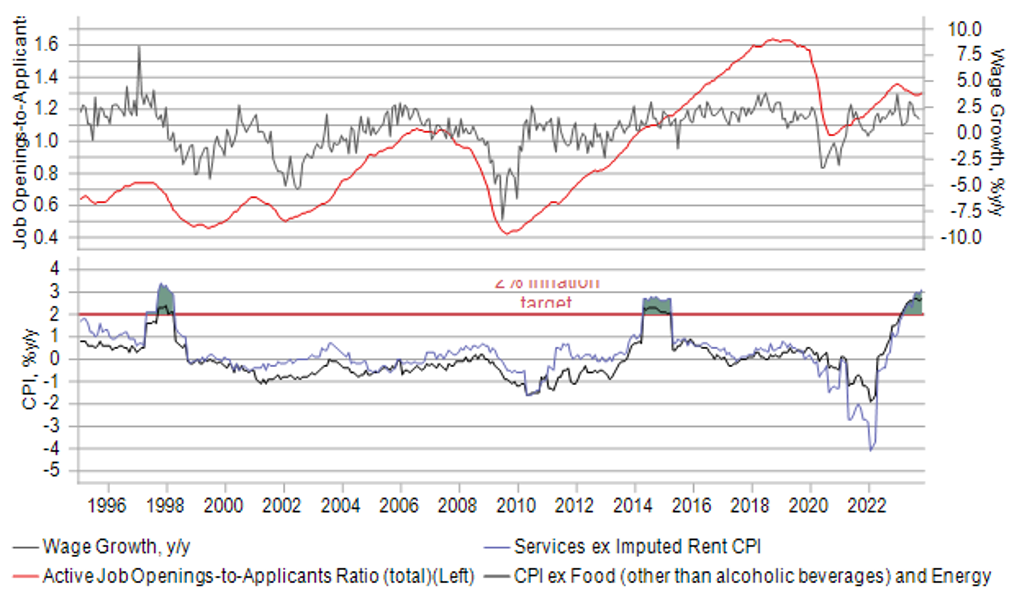
Source: Bloomberg, Macrobond & MUFG GMR
That would involve lifting the key overnight policy rate by 20bps to +0.10% to provide some positive cushion above zero percent. The BoJ want to move away from both NIRP and ZIRP! The next BoJ meeting on 19th December will of course be key in terms of how strongly the BoJ decides to communicate a possible change is more imminent. The meeting will follow a busy week for the markets next week with the Fed, ECB and BoE meeting along with the SNB and Norges Bank. What market conditions are like will be important but that meeting is an obvious platform for some possible signals of a change in stance ahead. That said, we can’t rule out the BoJ remaining dovish and pushing back on a change in stance although we would not necessarily conclude from that that a January hike will therefore not happen. The BoJ may not want strong speculation ahead of the January meeting.
Today’s US jobs data saw a close-to-consensus print of +199k although the unemployment fell 0.2ppt to 3.7%. The FOMC next week is likely to push back on the idea of a rate cut as soon as March and today’s jobs report suggest that is feasible . So after the big drop in US yields and the now still substantial 110bps of rate cuts priced into the futures market for 2024, the near-term outlook is more favourable for some more retracement of this move that could help lift yields. However, we would not expect a big move higher in yields. The reality is that the Fed is done and rate cuts are coming in H1 2024. It will be hard for Powell to explicitly argue against that.
So very short-term, and after such a large scale move lower, it is possible that we see some modest retracement of this JPY strength. It really depends on the level of hawkish/dovish communications we get from the key central bank meetings next week. In addition, given the higher expectations of a BoJ policy change on 19th December (which we do not expect), that could offer further appetite for some renewed selling in the wake of an unchanged policy decision. Again how willing the BoJ would be to communicate on the possibility of a change in January will also be important. If we do see some retracement of this JPY strength, the weight of positioning would likely limit the move and would be a chance to buy cheaper JPY. While BoJ developments are important, of greater importance is the decline in global inflation and the associated decline in global yields. Long CHF/JPY is just one example of a global inflation trade and has gained nearly 50% since the start of 2021. That is an extreme move and with the macro driver behind trades like that now reversing, JPY strength surely lies ahead.
The JPY move this week is likely to be a key marker that signals a turn in the trend of JPY depreciation, in place since the global inflation shock saw USD/JPY break sharply higher in March 2022. We don’t see a BoJ hike this month but any JPY selling over the near-term is unlikely to be sustained given the changes in the global macro backdrop
USD/JPY CATCHING UP WITH GLOBAL YIELD MOVES
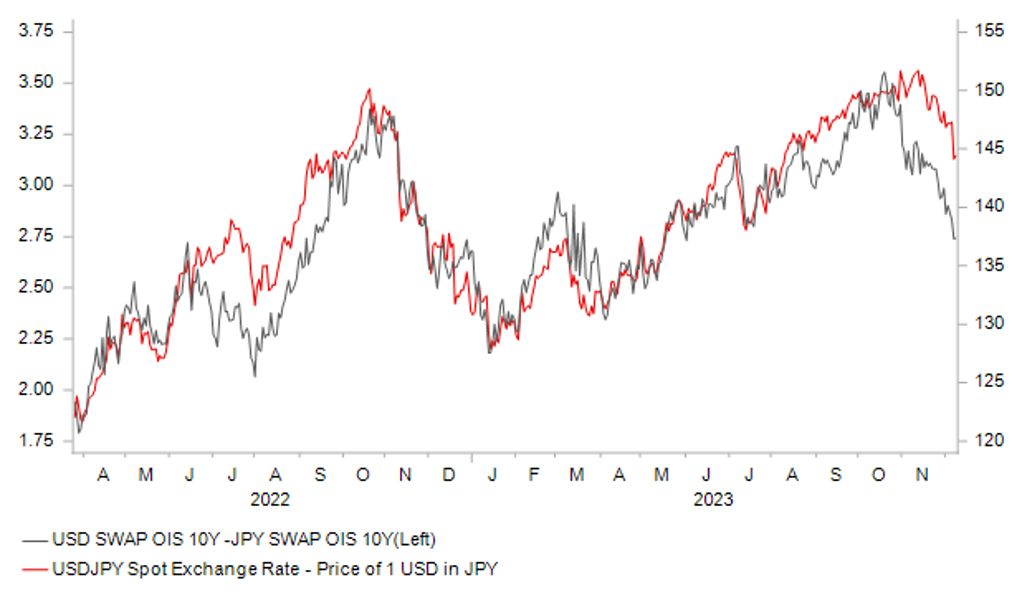
Source: Bloomberg, Macrobond & MUFG GMR
USD/JPY CHANGE NOW IN LINE WITH BROADER DXY MOVE
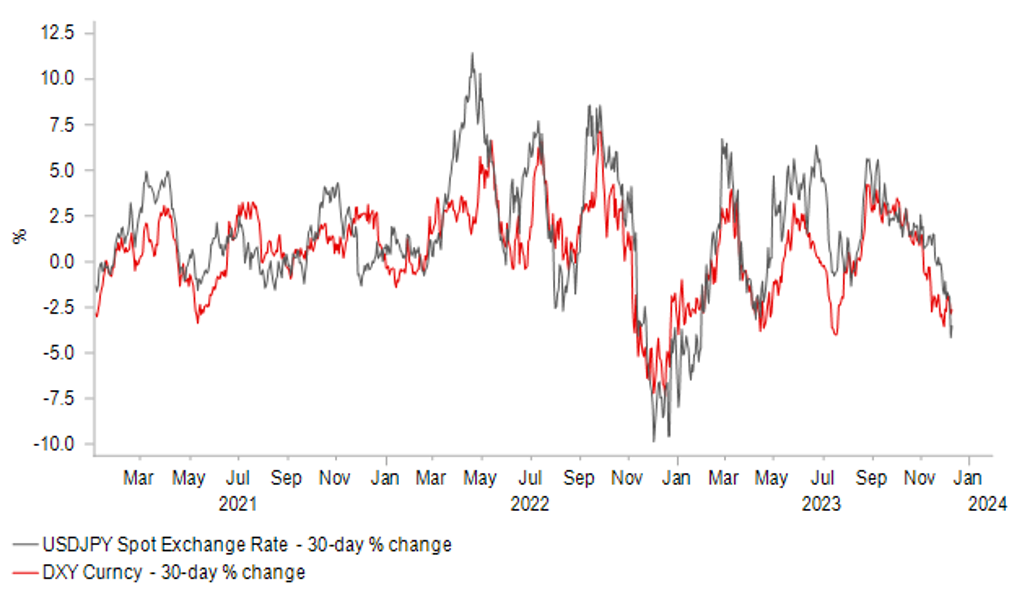
Source: Bloomberg, Macrobond & MUFG GMR
EUR: ECB’s justification for maintaining restrictive rates is quickly diminishing
The EUR has weakened sharply since the end of last month driven primarily by the recent dovish repricing of ECB policy expectations. After EUR/USD peaked at 1.1017 on 29th November, the EUR has since been one of the three worst performing G10 currencies as it has declined by around -1.7% against the USD, -0.7% against the GBP, and -3.8% against the JPY. It has resulted in EUR/USD falling back into the middle of this year’s trading range between 1.05000 and 1.1000. While EUR/JPY has fallen back sharply towards support from the 200-day moving average at the 154.00-level. EUR/GBP has also fallen back below the 0.8600-level and moved closer to year to date lows at around the 0.85000-level.
The main catalyst for the recent sharp weakening of the EUR was the release of the latest euro-zone CPI report that revealed headline inflation falling back closer to the ECB’s target in November (at 2.4% down from 10.0% a year ago). It was even more encouraging that the annual rates of core and services inflation both fell sharply by 0.6 percentage points as well helping to ease concerns over the risk of more persistent inflation in the euro-zone. The faster than expected slowdown in inflation has caught ECB policymakers by surprise. It even prompted the normally hawkish ECB Executive Board member Isabel Schnabel to describe developments as “quite remarkable”. The stage is now set for the ECB to revise down their forecasts for inflation at next week’s policy meeting. Headline and core inflation forecasts for 2024 are both expected to be lowered by around 0.3ppts to 2.9% and 2.6% respectively. More importantly for market participants, the forecasts for 2025 and beyond could now show inflation returning to the ECB’s target at around 2.0%. It would provide justification for the ECB to officially end their hiking cycle, and provide further encouragement to market participants that the ECB will begin to reverse course next year.
The euro-zone rate market has already moved along way recently to price in both earlier and deeper ECB rate cuts for next year. Market participants are currently attaching around an 80% probability to the first rate cut being delivered as early as the March policy meeting, and for a total of around 140bps of cuts by the end of next year. If delivered it would help to bring the ECB’s policy rate closer to estimates of the neutral rate between 1.50% and 2.00%. It will become harder for the ECB to justify maintaining restrictive policy if inflation falls back to target and the euro-zone economy continues to stagnate next year. So while the ECB may attempt to push back next week against current market pricing it will be difficult to discourage expectations for earlier and deeper cuts if the economic data flow is moving in that direction.
In these circumstances, we expect the EUR to continue trading on a softer footing in the near-term. We expect EUR weakness to be more pronounced against the JPY (click here) resulting in EUR/JPY falling back below 150.00-level by early next year
PEAK IN PLACE FOR EUR/JPY?
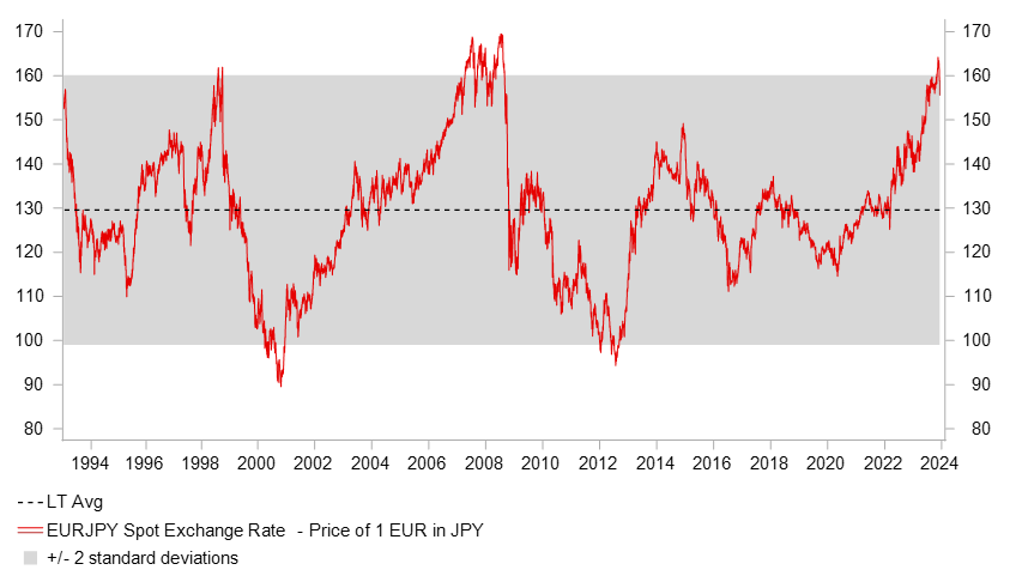
Source: Bloomberg, Macrobond & MUFG GMR
FALLING EZ YIELDS UNDERMINING CARRY APPEAL
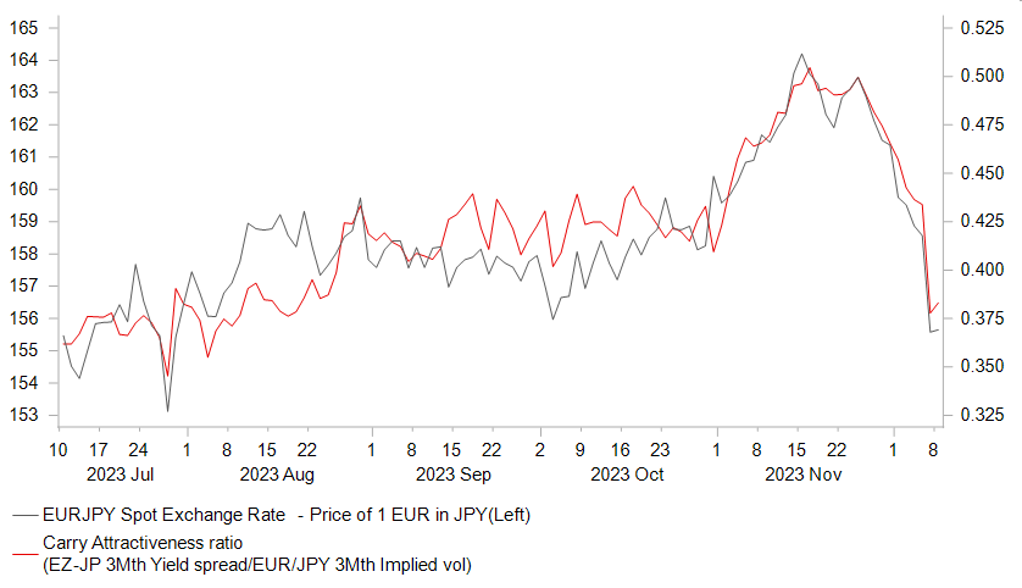
Source: Bloomberg, Macrobond & MUFG GMR
Weekly Calendar
|
Ccy |
Date |
BST |
Indicator/Event |
Period |
Consensus |
Previous |
Mkt Moving |
|
NOK |
12/11/2023 |
07:00 |
CPI YoY |
Nov |
-- |
4.0% |
!! |
|
NZD |
12/11/2023 |
21:45 |
Net Migration SA |
Oct |
-- |
7,510 |
!! |
|
AUD |
12/11/2023 |
22:20 |
RBA's Bullock-Speech |
!! |
|||
|
GBP |
12/12/2023 |
07:00 |
Payrolled Employees Monthly Change |
Nov |
-- |
33k |
!! |
|
GBP |
12/12/2023 |
07:00 |
Average Weekly Earnings 3M/YoY |
Oct |
-- |
7.9% |
!!! |
|
NOK |
12/12/2023 |
07:00 |
GDP Mainland MoM |
Oct |
-- |
0.3% |
!! |
|
EUR |
12/12/2023 |
10:00 |
Germany ZEW Survey Expectations |
Dec |
-- |
9.8 |
!! |
|
USD |
12/12/2023 |
13:30 |
CPI YoY |
Nov |
3.1% |
3.2% |
!!! |
|
EUR |
12/12/2023 |
17:00 |
ECB's Villeroy Speaks |
!! |
|||
|
JPY |
12/12/2023 |
23:50 |
Tankan Large Mfg Index |
4Q |
11.0 |
9.0 |
!! |
|
GBP |
12/13/2023 |
07:00 |
Monthly GDP (MoM) |
Oct |
-- |
0.2% |
!! |
|
EUR |
12/13/2023 |
10:00 |
Industrial Production SA MoM |
Oct |
-- |
-1.1% |
!! |
|
USD |
12/13/2023 |
13:30 |
PPI Final Demand YoY |
Nov |
-- |
1.3% |
!! |
|
USD |
12/13/2023 |
19:00 |
FOMC Rate Decision (Upper Bound) |
5.50% |
5.50% |
!!! |
|
|
USD |
12/13/2023 |
19:30 |
Fed Chair Powell Press Conference |
!!! |
|||
|
NZD |
12/13/2023 |
21:45 |
GDP SA QoQ |
3Q |
-- |
0.9% |
!! |
|
AUD |
12/14/2023 |
00:30 |
Employment Change |
Nov |
3.3k |
55.0k |
!! |
|
SEK |
12/14/2023 |
07:00 |
CPI YoY |
Nov |
-- |
6.5% |
!! |
|
CHF |
12/14/2023 |
08:30 |
SNB Policy Rate |
-- |
1.75% |
!!! |
|
|
NOK |
12/14/2023 |
09:00 |
Deposit Rates |
-- |
4.25% |
!!! |
|
|
GBP |
12/14/2023 |
12:00 |
Bank of England Bank Rate |
5.25% |
5.25% |
!!! |
|
|
EUR |
12/14/2023 |
13:15 |
ECB Deposit Facility Rate |
-- |
4.00% |
!!! |
|
|
USD |
12/14/2023 |
13:30 |
Retail Sales Advance MoM |
Nov |
-0.1% |
-0.1% |
!! |
|
USD |
12/14/2023 |
13:30 |
Initial Jobless Claims |
-- |
-- |
!! |
|
|
EUR |
12/14/2023 |
13:45 |
ECB President Lagarde Press Conference |
!!! |
|||
|
EUR |
12/15/2023 |
09:00 |
HCOB Eurozone Manufacturing PMI |
Dec P |
-- |
44.2 |
!! |
|
EUR |
12/15/2023 |
09:00 |
HCOB Eurozone Services PMI |
Dec P |
-- |
48.7 |
!! |
|
GBP |
12/15/2023 |
09:30 |
S&P Global/CIPS UK Manufacturing PMI |
Dec P |
-- |
47.2 |
!! |
|
GBP |
12/15/2023 |
09:30 |
S&P Global/CIPS UK Services PMI |
Dec P |
-- |
50.9 |
!! |
|
EUR |
12/15/2023 |
10:00 |
Labour Costs YoY |
3Q |
-- |
4.5% |
!!! |
|
USD |
12/15/2023 |
14:15 |
Industrial Production MoM |
Nov |
0.2% |
-0.6% |
!! |
Source: Bloomberg, Macrobond & MUFG GMR
Key Events:
- There is a heavy schedule of central bank policy updates in the week ahead. The Fed (Wed), SNB (Thurs), Norges Bank (Thurs), BoE (Thurs) and ECB (Thurs) will all hold their final policy meetings of 2023.The Norges Bank is the only central bank that has signalled that it could raise rates further by 25bps at next week’s policy meeting. The Norwegian rate market currently views the policy decision as a close call between leaving rates on hold and delivering one final hike.
- In contrast, recent favourable inflation developments in Europe and in the US should result in the BoE, ECB, Fed and SNB signalling with more confidence that their rate hike cycles have likely ended. The ECB and SNB have stronger justification to call an end to their rate hike cycles. Market attention will be mainly focused on how much the major central banks of the BoE, ECB and Fed push back against market expectations for earlier and deeper rate cuts next year. So far BoE officials have provided the strongest pushback. We do not expect any of the three major central banks to fully endorse current market pricing for more aggressive rate cuts next year. The lowest rate of inflation is currently in Switzerland (HCPI) at only 1.6% in November which alongside the strengthening CHF could provide more justification for a bigger dovish shift in the SNB’s policy guidance.
- The main economic data releases in the week ahead include: i) the latest UK labour market report (Tues), ii) US CPI report for November (Tues), and iii) US retail sales report for November (Thurs). While the data releases are unlikely to alter expectations for next week’s Fed and BoE policy meetings, evidence of stronger UK wage growth, US consumer spending and/or US inflation would challenge current market expectations for more aggressive BoE and Fed rate cuts next year.



